The Problem: House Wrens may destroy eggs and young of other cavity-nesters.
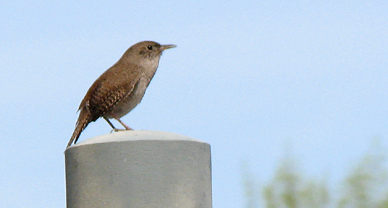
If you place nest boxes near or in shrubs, edges of woods, or hedgerows, sooner or later you may hear a bubbly song. A close look reveals it’s coming from a small brown bird with a stubby tail and long, sharp-pointed bill. A House Wren has discovered your boxes. If you aren’t sure what one sounds and looks like, click here for a YouTube video of a House Wren in action. Unfortunately, if you do have a wren at swallow boxes you must find ways of reducing House Wren damage to Tree Swallow nestings.
House Wrens are abundant birds. Partners in Flight’s Avian Conservation Assessment Database Scores put their numbers at 190,000,000 in 2021, making the species by far the most common native North American cavity-nesting landbird. In comparison PIF estimated there were 23,000,000 Eastern Bluebirds and 19,000,000 Tree Swallows.
Like Tree Swallows and bluebirds, House Wrens are cavity-nesters that can’t make their own cavities. And though tiny in size, House Wrens have developed effective methods for competing with larger species for these crucial resources, methods that can mean big trouble for Tree Swallows and bluebirds. So, for you, if House Wrens have discovered your boxes you will need to decide whether or not to remove the boxes.
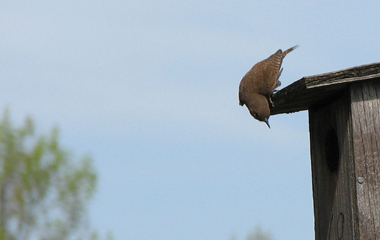
House Wrens migrate north later than Tree Swallows and bluebirds. They often arrive on the scene when the swallows and bluebirds are already building nests or have eggs or small nestlings. If the wrens find unoccupied cavities in the shrubby tangles they prefer they may leave the other species’ nests alone. However, if you have swallow or bluebird nests anywhere near those shrubby tangles the wrens may destroy them. The Tree Swallow nest below is in danger.
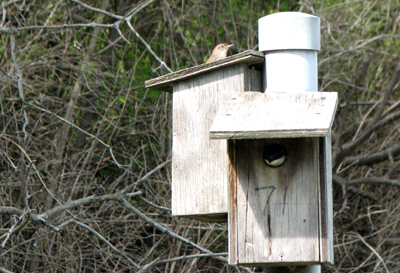
How can you tell if House Wren damage is occurring in Tree Swallow nest?
Classic signs of House Wren depredation include coarse twigs, typical of wren nests, placed on top of existing swallow or bluebird nests, eggs with smallish two-holed punctures found in the nest, or punctured eggs or small dead swallow or bluebird nestlings on the ground beneath the nest box where they’ve been thrown.
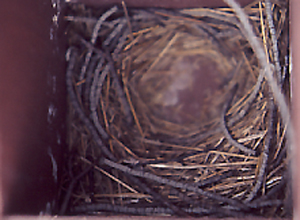
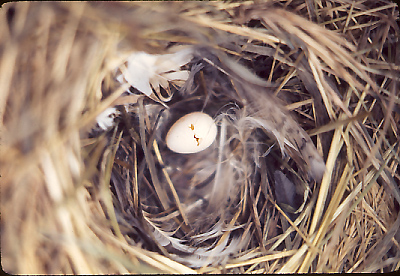
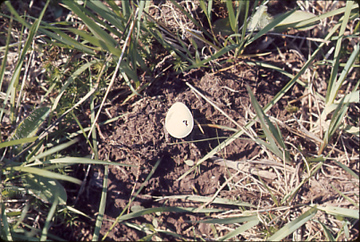
To compound the problem House Wrens don’t use most boxes they take over. Instead, males may claim several and construct “dummy nests” of twigs in each as part of his territorial behavior and to attract females. A female will then choose one and add a lining of grasses and feathers before laying her own clutch of whitish eggs heavily covered with tiny brownish or reddish speckles. The wren nest below was built over a Tree Swallow nest.
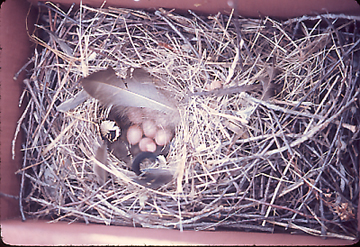
The best method for reducing House Wren Damage to Tree Swallow nestings is to keep nest boxes far away from dense bushes, woods, and hedgerows.
Are House Wrens legally protected?
Yes, House Wrens are native songbirds, protected by law. Therefore, you cannot kill, or trap and relocate adult House Wrens. It is also illegal to interfere with or remove an active wren nest, defined as one with a lining, or eggs, or young. However, dummy nests of twigs alone are apparently not considered “active” in a legal sense, and may be removed.
How can you keep House Wrens out of swallow or bluebird nests?
There is no swallow or bluebird box design that will exclude or deter House Wrens. The tiny wrens can slip inside any box that will admit swallows or bluebirds.
The best way to prevent House Wren damage to Tree Swallow nestings is to locate boxes far from wren habitat. If you can, place boxes hundreds of feet away from shrubby areas. If you can’t, and wrens find the boxes, relocate the boxes or eliminate them altogether. It’s much better to have fewer boxes than to allow wrens to destroy nestings. Since we started placing our swallow boxes well out in open fields, no nests have been destroyed by wrens. Unfortunately, this option isn’t as acceptable for bluebirds, which prefer at least a scattering of shrubs near their nests.
For a very detailed discussion of how to deter House Wrens check the Sialis web page on House Wrens. This page mentions a rather new technique, wren guards, (below). We haven’t tried these but suspect they might work for Tree Swallows when constructed and used as Sialis describes.
Please don’t create clusters of closely-spaced boxes. That’s an invitation for House Wren damage.
Some peoples’ reaction to competition is to put up more boxes. They reason that this “gives everyone a chance to nest.” But this seldom works. More is not better when one is trying to prevent House Wrens (or House Sparrows) from destroying other species’ nests. Don’t saturate your yard with nest boxes if you are hoping for either Bluebirds or Tree Swallows. Box clusters like the one below are magnets for both House Wrens and House Sparrows, whose populations may then explode.
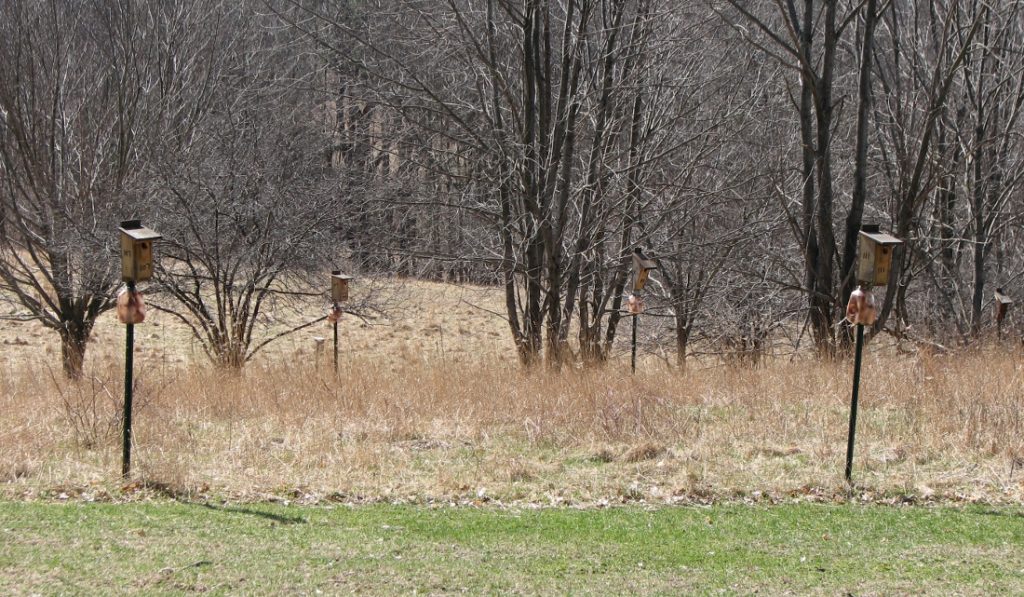
Enjoy House Wrens, but be careful where you put their boxes.
In spite of what we’ve said we welcome House Wrens to our home. We enjoy their summer-long presence at our home. But we take pains to use differing habitat preferences to prevent our wrens from competing with other species. Our wren box is in a woodsy part of our backyard where no swallows or bluebirds would attempt to nest.
The lesson is that boxes for swallows or bluebirds must be placed with care. Any location found attractive to both wrens and swallows or wrens and bluebirds should not be used in the future. For more on Tree Swallow nest box location see Placing Tree Swallow Boxes and Finding Sites for Tree Swallow Projects.
While swallows and bluebirds can co-exist, nesting close together in paired boxes, this almost never works with House Wrens. So, if you manage for Tree Swallows or Bluebirds, never to place a box in or near wren habitat. And if you weren’t aware of the potential problems, and find boxes where swallow or bluebird nestings have been damaged or destroyed by House Wrens, consider removing the boxes permanently from those spots once you legally can.
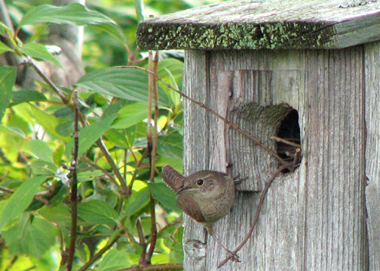
——————————————————————————
Home: Tree Swallow Nest Box Projects
Creating Tree Swallow Nest Box Projects
Spring Return
Nesting Season Behavior
Song and Calls
Nest Site Claiming
Pair Formation
Nest Building
Bird Flight
Mating and Paternity
Diary of One Season at Salmon Creek
Monitoring Nest Boxes and Keeping Records
Making Box Checks Keeping Box Records Control Sheets Season Summaries Print Sheets
Banding Your Tree Swallows Banding Adults Banding Nestlings
Tree Swallows in Research Research Bibliography Glossary of Terms